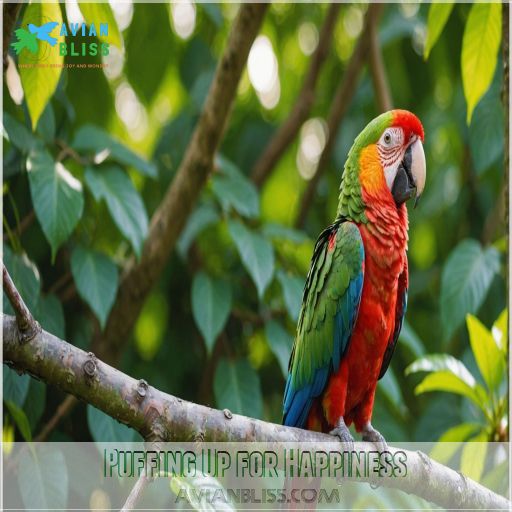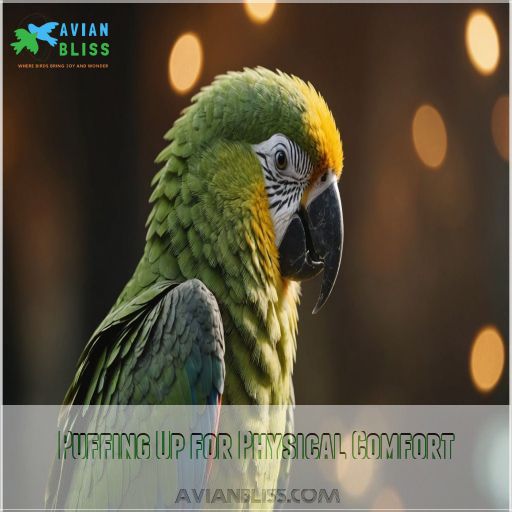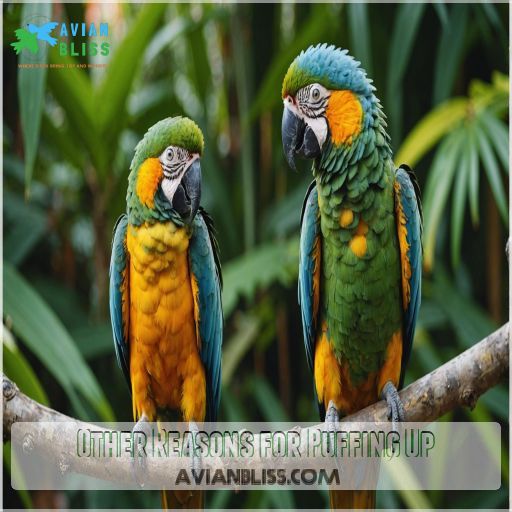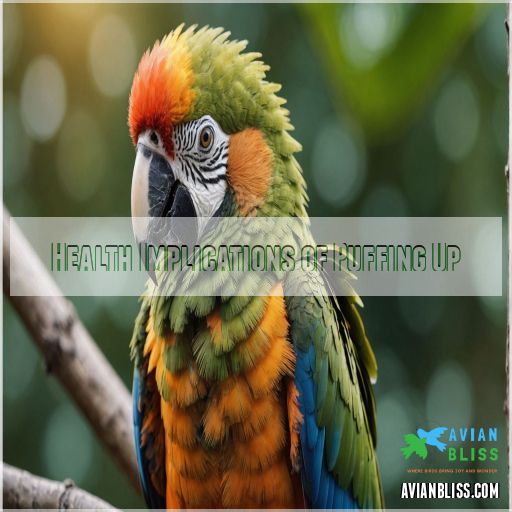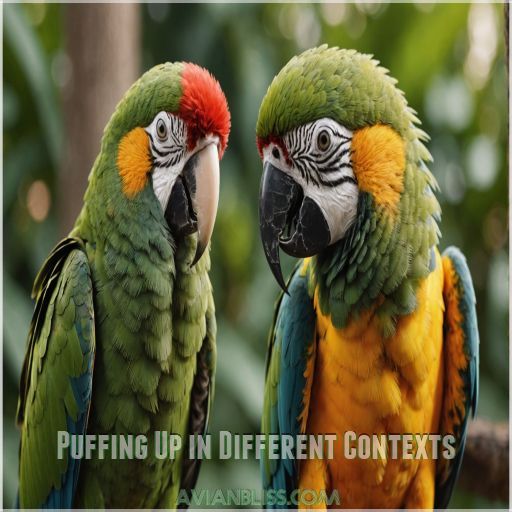This site is supported by our readers. We may earn a commission, at no cost to you, if you purchase through links.

It can mean they’re thrilled to see you, excited for a treat, or simply chilled out like they’re wearing a cozy feather blanket.
Sometimes, they puff up to impress a potential mate or to fend off imaginary predators by appearing bigger than they are.
But don’t overlook stress signals—puffing can also be a sign of anxiety or fear. Keep an eye on the context and your parrot’s other behaviors.
Want to truly understand your feathery friend? Explore the nuances behind those puffy feathers!
Table Of Contents
- Key Takeaways
- Why Parrots Puff Up
- Puffing Up for Happiness
- When Puffing Up Means Stress or Fear
- Puffing Up for Physical Comfort
- Other Reasons for Puffing Up
- What to Do When a Parrot Puffs Up
- Health Implications of Puffing Up
- Puffing Up in Different Contexts
- Frequently Asked Questions (FAQs)
- What does it mean when a bird puffs up?
- What does it mean when a parrot puffs up feathers?
- Why do parrots puff up?
- Why do parrots puff up and squat?
- What does it mean when a parrot puffs?
- What does it mean when a bird puffs itself up?
- Do birds puff up when happy?
- What does it mean when a bird is fluffing?
- How often should I bathe my parrot?
- What are the signs of an ill parrot?
- How much sleep do parrots need per night?
- What foods should I avoid feeding my parrot?
- How often should I change my parrots water?
- How often should I bathe my parrot?
- What are the signs of an ill parrot?
- How much sleep do parrots need per night?
- What foods should I avoid feeding my parrot?
- How often should I change my parrots water?
- Conclusion
Key Takeaways
- When your parrot puffs up, it’s like they’re wearing a feathered mood ring. They might be thrilled to see you, just chilling, or even trying to impress a mate. Keep an eye on their body language to truly understand their feathery signals.
- A parrot puffs up to play the big bird game, intimidating potential threats. It’s a fluffy attempt at predator defense, kind of like a pufferfish’s bluff in the bird world.
- On the comfy side, your parrot might fluff up just to feel snug and trap some warmth. Picture them cozying up like a bird wearing feather pajamas, settling in for some relaxation.
- Don’t overlook the stress signals. If your parrot puffs up more than usual, it could mean they’re stressed or feeling under the weather. Like a good pet detective, observe any changes and consider a vet visit if needed.
Why Parrots Puff Up
When your parrot puffs up its feathers, it’s not just trying to look like a fluffy ball; it’s communicating in a variety of ways.
From attracting a potential mate to simply feeling happy or needing a scare tactic, the puffing offers clues to your parrot’s mood and needs.
Attracting a Mate
Parrots, like nature’s flamboyant performers, puff up their feathers during mating rituals to catch a potential mate’s eye.
This courtship display makes them appear more attractive and enticing, enhancing their chances during mating season .
It’s their avian version of a romantic serenade!
Sign of Happiness and Excitement
When your bird puffs up its feathers, it’s like they’re wearing their happiness on their sleeve—er, wings!
This feathery display is a sign of contentment and excitement, akin to a cat purring.
Puffed-up joy shows they’re truly happy .
Scare Away Predators
Parrots puff up their feathers to appear larger, intimidating potential threats with a bird version of "look at me, I’m huge!"
It’s all about predator defense, showcasing a remarkable survival tactic where a seemingly harmless bird stands its ground with fluffy bravado .
Comfort and Relaxation
Imagine you’re lounging in your favorite chair—feathers fluffed, eyes half-closed, completely relaxed.
That’s your parrot during a moment of pure bliss.
They puff up to create a soft, cozy layer, signaling a stress-free, sleepy time in their safe space .
Puffing Up for Happiness
When your parrot puffs up its feathers, it’s often a sign of happiness and excitement.
This behavior can indicate your feathered friend is feeling content, whether they’re anticipating a treat or simply enjoying a playful interaction with you, much like how a bird might preen a human as a sign of affection.
Physical Attributes and Attractiveness
Puffing up those vibrant plumage patterns can make your parrot look like a feathery fashion icon.
It’s not just for show; this body language signals attractiveness cues.
Those parakeet mating rituals? They’re all about flaunting feather color variations for potential partners .
Anticipation of Positive Interactions
When your parrot expects a treat or a pet, they’ll puff up in sheer delight.
- Treat anticipation sparks excitement.
- Petting brings cozy joy.
- Playtime promises fun and warmth.
- Craving attention, they flaunt fluffy charm .
Playful Activities and Enthusiasm
After anticipating positive interactions, parrots often puff up during playful activities.
This is their way of showing enthusiasm, much like a kid with a new toy.
Happy chirps and active playtime with parrot toys keep their spirits high, encouraging social interaction and enrichment activities.
Expression of Affection and Excitement
A parrot puffing up can be a delightful display of affection and excitement.
This body language is a feathered friend’s "bear hug," signaling joy and readiness to bond.
These cues reflect an affectionate parrot’s happiness and enthusiasm in your presence .
When Puffing Up Means Stress or Fear
When your parrot puffs up, it might be stressed or scared, like how you’d feel if a bear suddenly walked into your kitchen.
They use this behavior to release tension, protect themselves from perceived threats, or simply react to unsettling changes in their environment—kind of like when your favorite coffee spot changes their seating arrangement.
Releasing Tension and Anxiety
Sometimes, your parrot puffs up to release tension or anxiety, much like a human taking a deep breath.
Provide stress-relieving toys and calming techniques.
Environmental enrichment and recognizing anxiety triggers can help.
Understanding parrot body language leads to a happier, relaxed companion.
Perceived Threats and Defense Mechanisms
When parrots puff up, they may be signaling a perceived threat, triggering a defense mechanism.
This body language can indicate fear, as the bird tries to appear larger and more intimidating to scare away potential predators.
Changes in Environment or Routine
Parrots may puff up due to changes in environment or routine, which can make them feel stressed or fearful.
You might notice:
- New home adjustments causing anxiety
- Travel stress affecting their mood
- Cage changes disrupting comfort
- Diet shifts altering routine stability
Lack of Mental Stimulation or Social Interaction
Brighten your parrot’s day by tackling boredom with engaging enrichment activities and social interaction.
Remember, variety is the spice of life!
Rotate toys, change routines, and interact often to address boredom signs and fulfill their social needs while understanding parrot behavior.
| Activity | Frequency | Description |
|---|---|---|
| Toy Rotation | Weekly | Swap old toys for new ones |
| Playtime | Daily | Engage in interactive games |
| Social Interaction | Several times | Talk, sing, or spend time |
| Foraging Challenge | Occasionally | Hide treats or toys to find |
, ,
Puffing Up for Physical Comfort
When your parrot puffs up, it might just be getting comfy like you snugging under a blanket on a chilly day.
They fluff their feathers to trap air and regulate temperature or to speed up drying after a bath, all while looking adorably content.
Regulating Body Temperature
Switching from fear to comfort, parrots adjust their feather fluffing for temperature control. Like donning a cozy blanket in cold weather, puffing up helps them trap warm air. In summer heat, it aids in heat regulation by allowing cooler air to circulate.
- Feather Fluffing: Insulates against cold.
- Temperature Control: Adapts to seasonal changes.
- Cold Weather Behaviors: Essential for warmth maintenance.
Drying Up Wet Feathers
After a bath, your parrot puffs up, shaking off water like a dog emerging from a dip. It’s nature’s blow dryer!
| Action | Purpose |
|---|---|
| Shaking | Water removal |
| Preening | Feather drying |
| Sun exposure | Post-bath warmth |
Embrace your parrot’s quirky routine!
Relaxation and Contentment
When a parrot puffs up its feathers, it’s like cozying up in a warm blanket.
This behavior often signals relaxation and contentment.
Your feathered friend might:
- Settle in for a nap
- Enjoy your company
- Feel secure and happy .
Trapping Air for Insulation
When the mercury drops, parrots fluff up their feathers to trap pockets of warm air, acting as natural insulation to maintain their toasty body temperature.
This clever adaptation helps them weather even the chilliest winters.
Other Reasons for Puffing Up
When your parrot puffs up, it might just be keeping its feathers in tip-top shape or telling another bird, "Back off, this perch is mine!"
Sometimes, they’re just being extra watchful, making sure they’ve got all angles covered in case they need a quick getaway.
Preening and Feather Maintenance
Beyond drying wet feathers, puffing up during preening keeps your parrot’s plumage in tip-top shape.
It’s a grooming routine involving feather health, beak trimming, and dust baths.
Imagine it as a DIY spa day!
This behavior also helps in dislodging parasites, ensuring their colorful, vibrant feathers continue to steal the show .
Displaying Dominance or Aggression
Your parrot puffing up could be a sign of asserting dominance or displaying aggression.
Recognize these cues in their body language:
- Social Hierarchy: It’s like a feathered version of a power suit.
- Territorial Behavior: Claiming their space, just like pets marking spots.
- Threats and Warnings: A vibrant hint to back off or face the squawk!
Hiding or Protecting Themselves
Like a feathered ninja of the jungle, your parrot may puff up to keep potential threats guessing.
This isn’t just about looking bigger; it’s camouflage 101.
When parrots sense a predator lurking, they engage their protective instincts, using their flamboyant plumes for defense and evasion, blending into their environment .
What to Do When a Parrot Puffs Up
When your parrot puffs up, it’s like them saying, "Hey, look at me!" but not always for the same reason.
By understanding their feathery intentions, you can help them stay happy and healthy, providing the right mix of excitement, comfort, and care.
Identifying the Underlying Cause
When your parrot puffs up, figuring out why is a must.
Check these:
- Body language cues – Is it happy or stressed?
- Feather condition – Any changes?
- Parrot’s history – Previous behavior patterns?
- Environment changes – Anything new?
Understanding leads to better care. (Source)
Providing a Stimulating Environment
Enrich your parrot’s life with a variety of chew toys, foraging puzzles, and climbing structures.
Rotate these items to maintain their interest and prevent boredom.
Providing mental stimulation is key to a happy, healthy companion.
Offering Social Interaction and Attention
Boost your parrot’s happiness through bonding and trust-building activities.
Spend quality playtime with games and enriching routines, using positive reinforcement to show affection.
Engage your feathered friend with creative playtime ideas to nurture a joyful, connected relationship .
Addressing Stress and Anxiety
Tackle stress in your lively feathered friend by spicing up their routine! Try these ideas:
- Create enriching environments with toys and stimulating activities .
- Engage in daily social interaction and playful activities.
- Practice relaxation techniques like soothing music .
Health Implications of Puffing Up
When your parrot puffs up, it might be trying to tell you something’s off, like not feeling well or being under the weather.
Keeping an eye on their overall health and consulting an avian vet when needed helps your feathery friend stay chipper and chirpy.
Signs of Illness or Discomfort
When your parrot puffs up, it might be waving a red flag about its health.
Look for signs like feather plucking or respiratory issues.
Here’s a quick guide:
| Symptom | Possible Cause |
|---|---|
| Feather plucking | Anxiety |
| Dropping changes | Digestive issues |
| Loss of appetite | Underlying illness |
| Lethargy | Discomfort |
If symptoms persist, consult a vet.
Monitoring Overall Health
Keep an eagle eye on your parrot’s feather condition, dropping changes, appetite shifts, and behavioral quirks.
Notice weight changes like a hawk; even small shifts can reveal important health clues.
Staying in tune with these signs helps guarantee your parrot’s vibrant well-being. .
Seeking Professional Help When Necessary
When your parrot puffs up and looks off-color, a visit to an avian specialist is essential.
They can diagnose hidden health issues with expertise that’s second to none.
Keep your feathered friend in top shape by noting:
- Sudden lethargy
- Vocal changes
- Odd droppings
Preventing and Managing Stress
Preventing and managing stress in your feathered friend is important.
Provide enrichment toys, maintain a consistent routine, and encourage social interaction.
Make sure they have ample space to explore and express natural behaviors.
With a little TLC, your parrot can thrive!
| Stress Indicators | Stress Management Strategies |
|---|---|
| Repetitive Behavior | Increase Enrichment |
| Fear | Positive Reinforcement Training |
| Loss of Appetite | Optimize Diet and Feeding |
Puffing Up in Different Contexts
You’ll notice your parrot puffing up in different contexts, whether it’s winding down for a cozy nap or showing excitement when interacting with you or other feathered friends.
These adorably fluffy displays often mean they’re relaxed, curious, or simply acknowledging a change in their environment, much like us settling into a comfy chair or greeting a new visitor.
Sleeping or Resting Positions
Parrot’s nighttime behavior isn’t just routine; it can include quirky sleeping positions.
- Feather fluffing for warmth.
- Tucking the head under a wing.
- Balancing on one foot.
- Choosing higher perches for safety and comfort.
Interacting With Owners or Other Parrots
In the grand symphony of parrot body language, puffing up during social interactions is a powerful expression.
It often signals a strong owner-parrot bond, reflecting contentment or excitement,
while also showcasing flock dynamics and training techniques to foster deeper connections .
Reacting to New or Unfamiliar Stimuli
Encountering new environments or unfamiliar stimuli can make a parrot puff up like it’s wearing a fancy feathered coat. This behavior might indicate:
- Stranger Danger
- Noise Reactions
- Curious Behavior
- Socialization Challenges
- Exploration of New Spaces
Such reactions are parrot-style caution!
Displaying Contentment or Relaxation
As your parrot fluffs its feathers, think of it as a bird slipping into cozy pajamas.
This relaxed behavior often signals comfort and contentment, much like your favorite chair after a long day.
See? Parrots enjoy their own "cozy corners" too!
Frequently Asked Questions (FAQs)
What does it mean when a bird puffs up?
When your bird puffs up, it might be staying warm, feeling cozy, or possibly signaling illness if it’s consistent.
Check for other signs of trouble, like not eating or unusual poop, to determine if help’s needed .
What does it mean when a parrot puffs up feathers?
A stitch in time saves nine, so understanding your parrot’s puffed feathers is worthwhile.
It could signal fear, happiness, mating, or aggression.
Know your feathered friend well to interpret their unique behavior accurately .
Why do parrots puff up?
Parrots puff up their feathers for various reasons: to signal happiness, show affection, attract a mate, keep warm, or express aggression.
Understanding these fluffy cues helps you bond better with your feathered friend .
Why do parrots puff up and squat?
Your parrot puffing up and squatting might signal comfort or readiness to engage in social interaction.
It can indicate relaxation or feeling secure, much like you snuggling under a cozy blanket on a chilly day .
What does it mean when a parrot puffs?
Isn’t it ironic that a parrot’s puffing up can signal both joy and a sneeze away from danger?
Parrots fluff up when they’re feeling everything from contentment to aggression—and sometimes they’re just showcasing feathers for a mate .
What does it mean when a bird puffs itself up?
When a bird puffs itself up, it might be trying to keep warm, relax for sleep, or indicate illness.
If it’s puffed up while awake, it could signal health issues, needing veterinary attention .
Do birds puff up when happy?
Birds often puff up their feathers when they’re feeling content, cozy, or even a little sleepy. It’s their way of expressing happiness and comfort in their surroundings.
What does it mean when a bird is fluffing?
Think of a bird fluffing its feathers like pulling up a cozy blanket to stay warm in winter. It traps warm air, offering insulation and comfort.
Besides warmth, fluffing can signal relaxation, illness, or readiness for sleep, depending on context .
How often should I bathe my parrot?
You should aim to bathe your parrot about three to four times a week.
Use a spray bottle with lukewarm water or let them splash in a shallow dish.
This will help to keep those feathers sparkling and healthy .
What are the signs of an ill parrot?
When your parrot puffs up, it might indicate illness.
Other signs include fluffed feathers, loss of appetite, lethargy, and changes in vocalization.
If these appear, visiting a vet becomes really important for your feathery friend’s well-being .
How much sleep do parrots need per night?
Parrots need about 10 to 12 hours of sleep each night to stay in tip-top condition.
Proper rest helps them maintain their vibrant personalities and avoid crankiness, much like us after a hearty nap .
What foods should I avoid feeding my parrot?
Steer clear of feeding your parrot caffeine, alcohol, avocado, chocolate, onions, garlic, and uncooked beans.
These foods are toxic and can harm their health.
Remember, a vibrant parrot is a happy parrot! .
How often should I change my parrots water?
Picture your parrot as a royal creature needing fresh water daily.
Swap their water twice a day to make sure it’s pristine, sparkling like a hidden oasis.
This will keep their little kingdom clean and nurture their curious spirit .
How often should I bathe my parrot?
You’ll want to bathe your feathered friend 3-4 times a week.
Mist them with a spray bottle or let them splash around in a shallow tub – they’ll love the chance to get squeaky clean!
What are the signs of an ill parrot?
Did you know that birds hide illnesses until they become severe?
Watch for signs like fluffed feathers, decreased vocalization, lethargy, or appetite changes.
If your parrot shows these symptoms, consulting with a vet could save its life .
How much sleep do parrots need per night?
Parrots typically need 10-12 hours of sleep each night.
Naturally adaptive, some may vary their sleep based on seasonal changes.
Make sure to provide a dark, quiet environment to help them rest and manage hormonal behaviors effectively (Source).
What foods should I avoid feeding my parrot?
Steer clear of feeding your parrot a toxic smorgasbord!
Avoid alcohol, chocolate, caffeine, avocado, onions, and uncooked beans.
Some birds, like the Sulphur-crested Cockatoo with its vibrant yellow birds with mohawks, have distinctive crests that can be affected by their environment. These can knock your bird’s feathers off with toxicity!
A little care helps your feathered friend stay chirpy and happy .
How often should I change my parrots water?
You should refresh your parrot’s water at least 2 to 3 times daily. Parrots often dunk their food, leading to gunky water that needs frequent changing for their health and happiness .
Conclusion
Jumping into parrot body language is like tuning into an old radio—sometimes you get static, but when you find the right station, it’s pure music!
Understanding why a parrot puffs up means you’ll decode signals from joy and relaxation to stress or defense.
Keep an eye on context, because your feathered friend’s puffy demeanor might just be their way of telling you they’re happy to see you or a little on edge.
Observing and responding appropriately makes sure mutual happiness.


